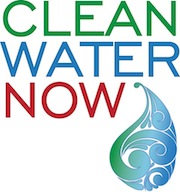The colors we’ve chosen for CLEAN WATER NOW are a reflection of our mission statement’s major goals and top priorities. Here’s their relevance and context:
CLEAN is green because it represents our commitment to assisting in the procurement and reliable delivery of adequate landscape and irrigation water to our home gardens, to our common open space plantings and to the faithful and diligent farmers who grow the food that we eat.
This non-potable water should also be of a guaranteed quality that poses no risk to the greater environs, to those who disperse it, or to those who inadvertently swallow or come in casual contact with it.
We recognize that clean water is not only a general public and biotic components right but our duty to pursue together as a significant aspect of California’s history and collective heritage.
WATER is blue to signify trustworthy, healthy, safe, high quality potable (drinking) water that everyone deserves running from their taps. Water that we and our families ingest or immerse ourselves in should be monitored, assessed and regulated to the maximum extent practicable. This will help to prevent illness, health hazards and insure public use benefits. Let’s face it, water is life!
We’re also committed to working diligently to investigate, develop and secure future potable supplies equal to our projected needs. We support the federal Clean Water Act and California’s Porter-Cologne Water Quality Control Act which provide governmental oversight and guidance in these matters. These laws regulate and have requisites we endorse; moreover, they propose achievable, specific, and realistic objectives for all surface and receiving waters.
NOW expresses our alarm and sense of urgency. Whether it’s advanced wastewater treatment systems, recycled, reused and reclaimed water, whether fresh groundwater extractions, or ocean and brackish desalination installations, our portfolio is in serious jeopardy and it needs a cohesive, long-term visionary strategy.
We need to immediately preserve and protect our precious ecosystems before they’re irreversibly damaged or degraded. Draining our streams and lakes isn’t responsible eco-stewardship nor will the combined habitat extraction strategies mentioned be adequate as our State continues to grow.
Through environmental restoration, we feel that properly functioning ecosytems will provide both healthier surface and sub-surface ground water. Eco-protection and intelligent, well-planned land use management could increase not only the reuse quantitative volumes available for our communities, but to higher qualitative environmental standards than they presently exhibit.
